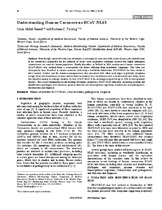| dc.contributor.author | Abdul-Rasool, Sahar | |
| dc.contributor.author | Fielding, Burtram C. | |
| dc.date.accessioned | 2013-10-06T20:00:09Z | |
| dc.date.available | 2013-10-06T20:00:09Z | |
| dc.date.issued | 2010 | |
| dc.identifier.citation | Abdul-Rasool, S. and Fielding, B.( 2010). Understanding human coronavirus HCoV-NL63. The Open Virology Journal, 4: 42-50 | en_US |
| dc.identifier.issn | 1874-3579/10 | |
| dc.identifier.uri | http://hdl.handle.net/10566/734 | |
| dc.description | Clinical features | |
| dc.description | Pathogenesis | |
| dc.description | Diagnosis | |
| dc.description.abstract | Even though coronavirus infection of humans is not normally associated with severe diseases, the identification
of the coronavirus responsible for the outbreak of severe acute respiratory syndrome showed that highly pathogenic
coronaviruses can enter the human population. Shortly thereafter, in Holland in 2004, another novel human coronavirus
(HCoV-NL63) was isolated from a seven-month old infant suffering from respiratory symptoms. This virus has
subsequently been identified in various countries, indicating a worldwide distribution. HCoV-NL63 has been shown to
infect mainly children and the immunocommpromised, who presented with either mild upper respiratory symptoms
(cough, fever and rhinorrhoea) or more serious lower respiratory tract involvement such as bronchiolitis and croup, which
was observed mainly in younger children. In fact, HCoV-NL63 is the aetiological agent for up to 10% of all respiratory
diseases. This review summarizes recent findings of human coronavirus HCoV-NL63 infections, including isolation and
identification, phylogeny and taxonomy, genome structure and transcriptional regulation, transmission and pathogenesis,
and detection and diagnosis. | en_US |
| dc.language.iso | en | en_US |
| dc.publisher | Bentham Science | en_US |
| dc.rights | Copyright Abdul-Rasool and Fielding; licensee Bentham Science Publishers. This is an Open Access article distributed under the terms of the Creative Commons Attribution License (http://creativecommons.org/licenses/by-nc/3.0/), which permits unrestricted use, distribution, and reproduction in any medium, provided the original work is properly cited. | |
| dc.subject | Human coronavirus HCOV-NL63 | en_US |
| dc.title | Understanding human coronavirus HCoV-NL63 | en_US |
| dc.type | Article | en_US |
| dc.privacy.showsubmitter | false | |
| dc.status.ispeerreviewed | true | |
| dc.description.accreditation | Web of Science | en_US |

